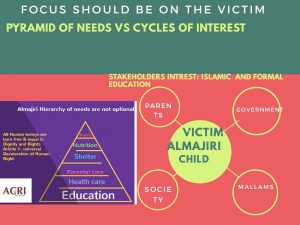
Recently I read an article online in which the author emphasised the need to report data through story and not story through data. The author’s argument was that psychologists have found out that most people relate to stories about individuals as against dishing out “facts and figures” that do not have human face to them. And this, one can see in the national and local political discourse on Nigeria’s issues, mainly by Nigerians. Let’s say I referenced an international report that says that there are 10.5 Million out-of-school children in the country and that there is an urgent need for the government to address the issue – which is true; depending on which side of the political divide an individual is, it’s not out of place or uncharacteristic that some will interpret the issue based on their political leanings or personal politics, for or against the incumbent government. Arguments like: it didn’t start today; you have to blame the present government; tell them to stop having children they can’t cater for; this government is not interested in education of the people etc. might be advanced as the political table tennis match goes on. Unfortunately, the humane part of the story will be lost and the 10.5 Million out-of-school children will become the victims of the political ping pong.
Now, imagine if I was to tell you about the story of a child who missed out of school because his guardian could not afford to pay his tuition fees; like in the case of the boy in “Why Are You Not in School? The Story of A Young Boy in Nigeria.”, you probably would react to it and empathise with the child’s inability to attend school for a particular period of time as against the case of the supposedly 10.5 million out-of-school children, most of whom have never been to school before and may most likely not access any formal education in childhood. This is the dilemma with telling a human experience through data.
As you can see, my last use of 10.5 million out-of-school children was qualified with ‘supposedly’. This is so because in a recent article by @AfricaCheck, it was established that the 10.5 million out-of-school children population in Nigeria was reported to be outdated; as it was based on a 2010 data. The new figure is 8.7 million according to Friedrich Huebler of the UN who was referenced in the article “Does Nigeria have the world’s most girls out-of-school, as activist Malala claimed?” @AfricaCheck reported that:
UNESCO said they based the 2010 figure on enrollment statistics from Nigeria’s education ministry. The age distribution was then estimated using data from a 2011 survey by the National Bureau of Statistics, Friedrich Huebler, who is with the institute’s education standards and methodology section, explained to Africa Check.
In 2014, the data agency revised the 2010 out-of-school figure for Nigeria from 10.5 million to 8.7 million, Huebler said. This was because the UN Population Division had produced new population estimates for that year. Of these, 57% of the children were estimated to be girls, a total of close to 5 million.
Nigeria has the highest number of out-of-school children in the world. This is unacceptable — education is the passport to the future of this country. Our vision is to see to the attainment of 100% education rate for all Nigerian children age 12 and below. #ChildrensDay
— Dr. Abubakar Bukola Saraki (@bukolasaraki) May 27, 2018
Even though I have always used the 10.5 million data I do doubt the reliability of it due to how dated it had become. But the data has always been referenced by top government officials – as you can see from the above tweet by Nigeria’s senate president, Senator Bukola Saraki, as well as the mainstream media. However, the 8.7 Million out-of-school children data remains questionable to me on two propositions.
Firstly, the definition of out-of-school children by the United Nations (UN) is not broad enough to cover the whole of the compulsory education provision of the Nigerian education system. The organisation defines out-of-school children as “Children in the official primary school age range who are not enrolled in either primary or secondary schools.” With this definition it means that four (4) years out of the ten (10) years of the “free and compulsory” education in the country is unaccounted for in the data collected. Hence, 40% of the years supposed to be covered by the data – if the definition is localised and contextualised by the government – is unaccounted for.
Secondly, the frequency with which the data is collected is not consistent. With a gap of about four (4) years between 2018 and when the 8.7 million out-of-school children data was collected in 2014, it is most likely that about 50% movements in terms of transitions between: early childhood and primary education, primary and junior secondary education, and junior secondary and senior secondary education would have occurred. Hence, massive population shifts along education levels would have happened during the period. As such, the 8.7 million data would most likely be below the reality on ground.
Fund for out-of-school children (advocacy) in @FMENigeria's 2017 Appropriation bill.
I'm wondering if the #118,828,800 could have been better spent by funding public schools to reach out to their immediate communities and attract children into their classrooms. pic.twitter.com/STSsQTBeFx— Abdulghaniy Otukogbe (@otukogbe) August 4, 2018
Although, it is one thing to address the issues around the data, it is also another issue entirely for the human experience behind the data to become victims. Unfortunately, it isn’t the figure – 10.5 or 8.7 million – that is the real victim here but the children who are mainly from disadvantaged socioeconomic background. Perhaps, you’re wondering what I’m driving at here? It is about the provisions in the 2017 appropriation bill of the Federal Ministry of Education for out-of-school children related issues. Bizarrely, a whopping one hundred and eighteen million, eight hundred and twenty eight thousand and eight hundred naira (#118,828,800) was allocated for “advocacy” related activities in the appropriation bill. After extracting the figures from the bill, I was left wondering if it was a case of misplaced priorities or disingenuous use of public funds. Thus, prompting my tweet (above) on the issue.
My simple question to you, my invaluable reader, is – how many radio jingles, TV adverts, social media engagements or community programmes that relate to the issue of out-of-school children in the country and sponsored by the FME have you seen or heard about? I hope you do remember how active polio eradication programmes were and still are at both local and national levels? You are more likely to have experienced a stranger knocking on your front door to talk to you about polio vaccination and probably vaccinate a child in your household than experience any advocacy programme on out-of-school children sponsored by the FME.
Finally, to the policy makers that allocated the funds to the “advocacy” programmes, the country has a rich history of many successful advocacy strategies – for example, the numerous polio eradication campaigns – that you can learn from and duplicate. Maybe, you’re wondering on the replicability of such strategies, since they were carried out in the health sector, then why not look at the advocacy strategy used in 1954 to launch the provision of universal free education to every child in the then Western region of Nigeria by the Action Group government led by Late Chief Obafemi Awolowo, as detailed in the article “July 5: A free education flashback” by Odia Ofeimun.
Do you have any story or experience of successful advocacy programmes in the country that you would like to share? If yes, please drop a comment in the comment section below or send an email to: editor@edusounds.com.ng.
Please, leave your thoughts on this post in the comment section and feel free to share the article with your contacts.
Thanks for taking out of your precious time to read my article/s!
If you like this post, kindly subscribe and/or follow me on Twitter @otukogbe and @EdusoundsNg or on Facebook at edusoundsng.



